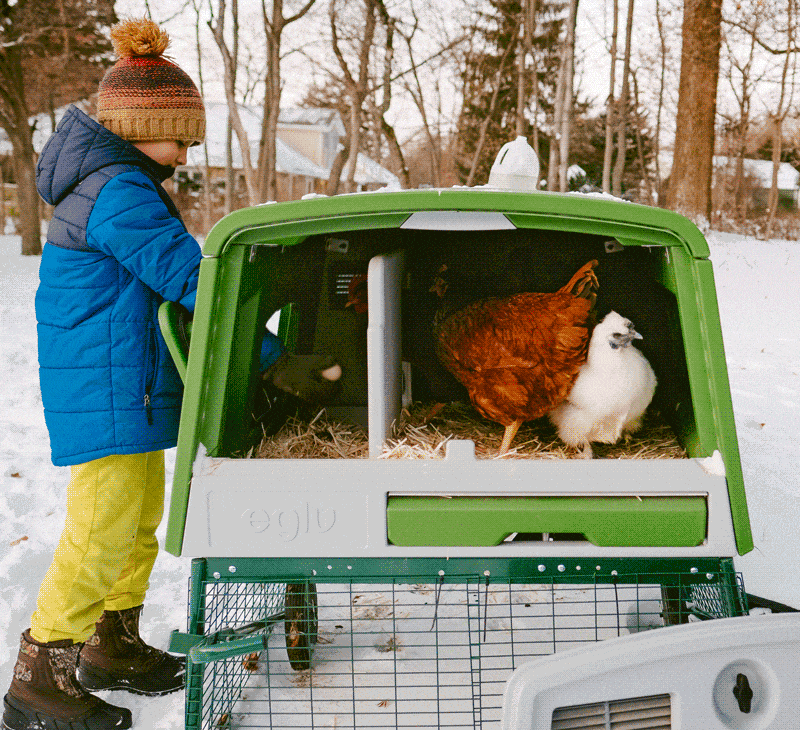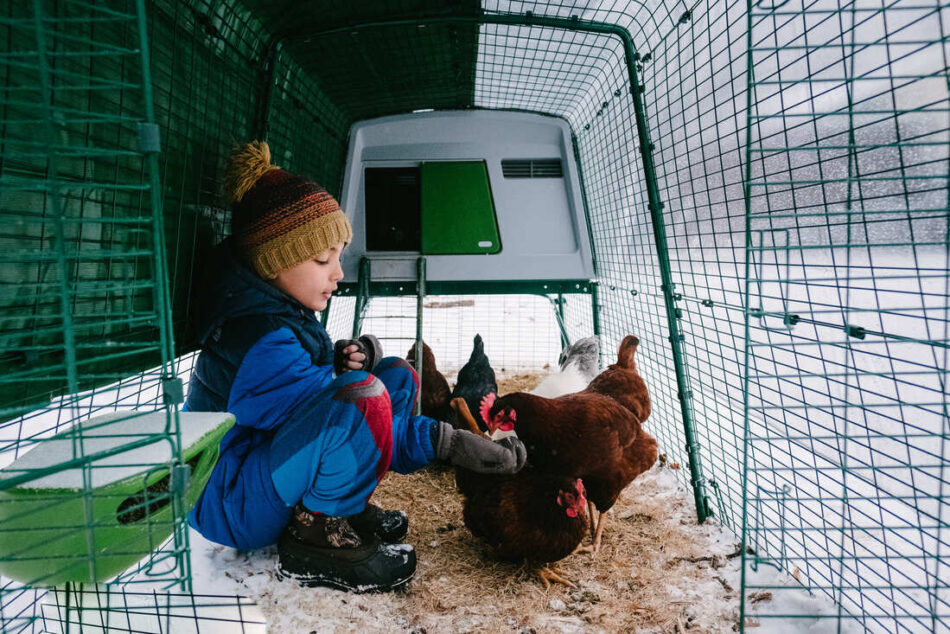How the Eglu Keeps Your Chickens Warm in Winter
During the winter, one of the biggest concerns among chicken keepers that have purchased, or are considering, an Eglu is how well it can keep their flock warm. In this blog, we will dive into the science behind the Eglu’s thoughtful design, with particular emphasis on how these features will help your chickens stay warm during the colder months.
Insulation
Insulation prevents energy from passing through it, and air is an excellent insulator! Think of your chickens in the cold – they fluff up their feathers in order to trap more air between their layers of feathers. Pretty amazing, right? By doing this, they create their very own insulation. Air is such a great insulator because it has very little conductivity, which is the ability to transfer heat. Air molecules are spread out, so even though warm, fast moving molecules are bouncing around within the air, they only lose heat when they come into contact with slower moving molecules to pass warmth off to – which in turns causes the temperature to cool. In short: air doesn’t have as many molecules for heat to pass its warmth off to, thereby keeping an area warmer for longer. Air is used to insulate many commonly encountered objects and structures – from your favorite puffer coat, to your thermos and even the walls of your home.
Just like the walls of your home, the Eglu’s unique twin-wall design captures air in between the layers, creating a “pocket” of insulation to surround the coop. Not only does this method prevent cool air from moving in, but it also keeps the body heat your chickens generate inside. On the flip side, the same method helps to keep heat out of the coop during warm weather.
Ventilation
Ventilation is any coop’s best friend – but it’s a delicate balance between how much airflow is needed. Too much airflow creates chilly drafts, and too little airflow causes moisture to build up inside the coop which can lead to multiple health issues for your hens.
Eglu coops are designed to allow air to flow through the coop through well positioned vents. This draft-free system ensures that clean air is able to circulate through the coop while still keeping your chickens warm. The moisture created by your chickens will be circulated out through the same process, preventing moisture buildup.
How chickens keep themselves warm
As mentioned, chickens have a built-in mechanism for creating their own insulated barrier from the cold. You’ll notice your chickens “molt” (shed their feathers) in preparation for the winter. While it may look alarming, your half-naked chickens will regrow thicker, more dense feathers for the winter. These dense feathers are used in their “puffing up” technique to help hold the longer feathers on top away from their skin. The thickness of their downy feathers underneath traps the air that their visible plumage is allowing in. The result is a fluffed up, warm (and adorable!) hen.
Chickens will also ramp-up their already fast metabolisms in the winter to help generate heat. Be sure to offer them extra feed during this time to support this metabolic shift! Feeding extra scratch grains or alfalfa hay in the evenings will help keep their body heat up on chilly winter nights.
As a cold-defense mechanism, blood flow will be redirected from your chickens’ legs and to their bodies in an effort to keep them warm. Their feather-less legs have scale-like coverings that trap some heat in, but often you’ll see your chickens warming up their chilly legs. Some hens will alternate standing on one leg in a flamingo pose to warm one leg up against their body. The hen will switch legs to repeat the process on the other side once one leg has been sufficiently warmed. You’ll also notice that chickens will drape their feathery skirts over their toes when they roost to warm them up! By giving them chicken perches or chicken trees in their run, they’ll have multiple opportunities to warm their toes after walking on the frozen ground.
The Eglu isn’t made of ice, but it can withstand it
Our Eglu coops might not be made of ice, but they’ve been created to withstand the elements! For particularly cold areas, extreme temperature jackets can be added for extra-insulation. And since you’re now a pro at understanding how air is a great insulator, you can see why adding another layer to trap even more air around your chicken coop will help keep more heat in and more cold out!
Inventing and engineering minds are always hard at work at Omlet, and the Eglu chicken coop is just one of many pet products designed with practical science to benefit both the animals and the people that love them! You can rest easy this winter knowing that your chickens will be nice and warm all season long in their Eglu coop.
This entry was posted in Chickens


One reply on “How the Eglu Keeps Your Chickens Warm in Winter”
Exactly how protective is an eglu with the jacket in single digit temperatures? I have 5 bantams in the smallest eglu…